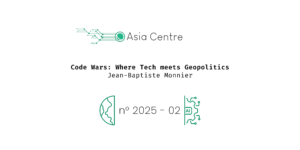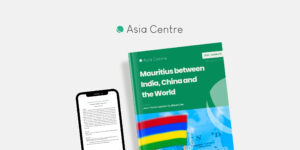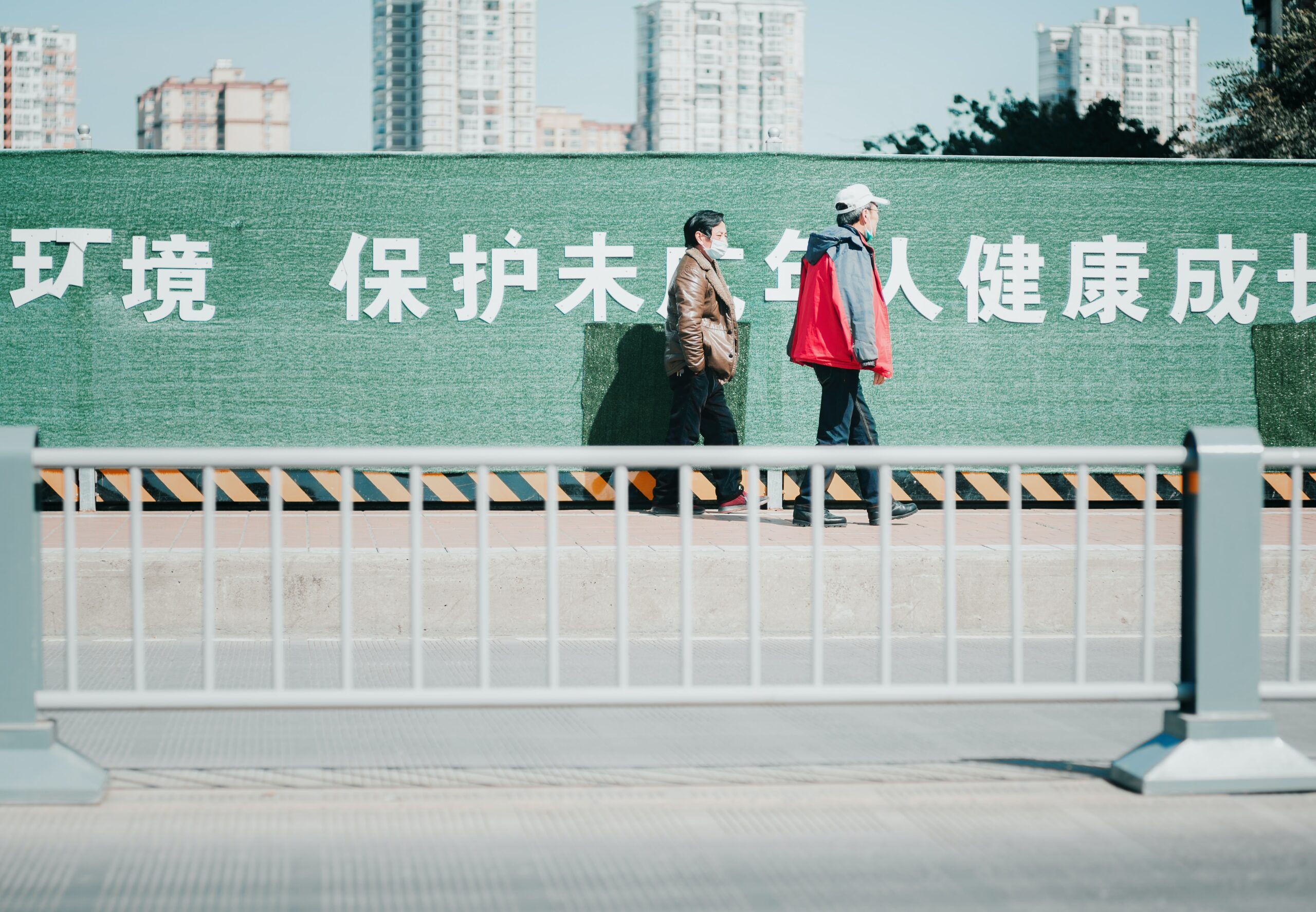In this article extracted from the Figaro Histoire issue “Mussolini, l’illusion fasciste”, Jean-Pierre Cabestan deciphers how the Covid-19 pandemic reinforced the power of the Chinese Communist Party and boosted Xi Jinping’s ambitions.
It can be found on the website of the newspaper Le Figaro: https://www.lefigaro.fr/histoire/chine-parti-puissance-pandemie-le-virus-du-pouvoir-20220222, and in full version by clicking on the button below:
Originating in China, the Covid pandemic has allowed the Communist Party and Xi Jinping to strengthen their power in unprecedented proportions. China is now emerging as the rival of the United States in the race to become a superpower.
As we enter 2022, the Chinese government has strong reasons to be satisfied. It has controlled the Covid-19 pandemic better than any other country. After a moderate slowdown, its economic growth remains above average. As for the Communist Party, the sprawling organization that has presided over the destiny of the People’s Republic since 1949, and its supreme leader, Xi Jinping, they are more powerful than ever: within the country’s borders, including Xinjiang and Hong Kong, but also outside, as China is now only opposed by a weakened group of Northern countries (the United States, the European Union and Japan in particular).
However, the picture is probably not as splendid as the CCP’s propaganda departments would like us to believe. One wonders how long the so-called “zero Covid” policy will hold up as the Omicron variant spreads like wildfire. The Chinese economy is also facing a number of difficulties, particularly in the real estate market, aggravated by local governments’ indebtedness. Finally, Washington, Brussels, but also Tokyo and Canberra, are very upset with Beijing over human rights and trade issues, but also because of the threats China poses to Taiwan, the South China Sea or the Senkaku (Diaoyu), the islets administered by Japan but claimed by the Chinese government for some 50 years.
Thus, one might wonder whether Xi Jinping might not fall into the famous “Thucydides trap”, conceptualized by the geopolitician Graham Allison in 2017, according to which the rising power will sooner or later come into conflict with the established power -the United States, and thus replay the conflict that opposed, in the Peloponnesian War, Athens and Sparta in the fifth century BC. In short, there are many uncertainties surrounding 2022, just like the uncertain future of the pandemic.
THE STRENGTHENING OF SOCIAL CONTROL
Because it first broke out in China, in Wuhan, at the end of 2019 before turning into a pandemic in the first months of 2020, the Covid-19 coronavirus could have caused an unprecedented economic, but also social and even political, crisis in the country. This was however not the case, thanks to the Party and, some would say in today’s People’s Republic, thanks to Xi Jinping himself and the power of his “thought”, a thought now taught in every school in the country.
After trying to hide the situation, to minimize the seriousness of the epidemic and to dissuade the World Health Organization from issuing a general alert, on January 23, 2020, the CCP took matters into its own hands through the voice of Xi: a sanitary cordon was imposed around Wuhan; each locality was called upon to protect itself. Since then, the spread of the disease has been hindered by the implementation of the social control that Communist China has made its own: the comings and goings of all residents are subject to the “green light” – so to speak – of a tricolored QR code (green, orange and red) provided by the government and that everyone must download onto their phone; only those with a green QR code are allowed to move around, the others are subject to a more or less strict quarantine.
There have been a few protests and dissonant voices, in particular that of Fang Fang, a woman writer, who took the initiative of writing a “Wuhan diary” to evoke the difficulties and dramas of the lockdown in this city -the first one to be hit by the pandemic-, and to post it on the Web. But they were quickly muzzled by the omnipotent Party.
The CCP’s grassroots organizations’ covering of the country, especially the urban areas (65 per cent of the population), as well as the mobilization of the party’s footsoldiers (95 million members) to monitor the entrances and exits of each residence, have helped a lot. As well as the omnipresent surveillance cameras and the famous “social credit” system, which is managed by the government and gives good and bad points to citizens according to their behaviour at work, in private or in public places. Thus, those who do not pay their debts or taxes, behave badly in public or neglect their parents may be subject to sanctions, such as being banned from travelling by plane or train. On the other hand, “model citizens” will receive benefits (better bank rates, hotel reservations without paying a deposit) or discounts on certain expenses (electricity).
Chinese society, more concerned about its health security than the protection of its individual freedoms, has, on the whole, complied with the containment measures imposed by the authorities. The result is there: officially, as of January 13, 2022, China has recorded only 116,641 cases of coronavirus and only 4,849 deaths.It is probable that these figures underestimate very largely the reality, because we know that the doctors and the hospitals received for instruction to index to the minimum the cases of Covid-19: contrary to what happens in particular in France, any death due to several causes of which Covid does not appear in the statistics. However, it must be noted that the high level of supervision and therefore of surveillance of the population has helped China to post a balance sheet which, even if it is increased tenfold by certain external studies, remains impressive in relation to the size of the population (France, with a population one-twentieth that of France, had at the same time nearly 11 million cases and 125,000 deaths).
THE IRRESISTIBLE RISE TO POWER
The inescapable role of the State, or rather the Party-State, in the Chinese economy has also enabled it to better absorb the aftershocks of the pandemic and to recover before others. As we know, China experienced a sharp slowdown in 2020: 2.2% growth instead of 6% the previous year. But in 2021, its economy has picked up again: +8% according to the most recent estimations. After a small increase in 2020 (+3.7%), Chinese exports grew by almost 30% in 2021 and the trade surplus by the same amount. A sign of the Party’s desire to control the private sector more closely, the antitrust measures taken since the end of 2020 against Alibaba and Tencent have not prevented these Internet and online shopping giants (Alipay and Taobao for Alibaba, WeChat and video games for Tencent) from continuing to expand while opening up the market to other players, and thus bringing more competition and innovative forces into the sector. Households savings remain very high (34% of GDP) and foreign exchange reserves have continued to grow, reaching $3.25 trillion in December 2021.
The pandemic has also not stopped China from continuing to modernize itself and innovate. Today, half of the world’s electric cars are driving in China. Already dominant in 2018 (84% of the population used it), online payment has become universal, propelled by Tencent (WeChat) and Alibaba (Alipay) thanks to the support of the state, which, while seeking to regulate these firms, has not weakened them. In many areas, China is now a serious competitor to the United States and other developed countries. While it is still lagging behind in some sectors, such as aircraft engines, it is gaining ground in others, such as artificial intelligence and hypersonic missiles.
It is clear that the Chinese economy is facing a number of challenges. The real estate sector is in crisis, with the most frequently cited example being the Evergrande Group, which is facing a US$300 billion debt. Consumption remains depressed, as households prefer to save for future education and health care expenses, or for possible living expenses linked to retirement. As a result, the economy is struggling to change its growth model and substitute exports with increased domestic consumption; in short, to introduce the “dual circulation” policy promoted by Xi. But these difficulties are not due to the pandemic, and the reform of the real estate sector, and in particular the gradual introduction of a property tax to stabilize the price of apartments, was long overdue, since access to property has become an unaffordable dream for the majority of Chinese.
Similarly, there is much talk about the worrying debt load of local governments, which have financed many infrastructure and real estate projects with the help of “financial vehicles” that have become fragile or even insolvent. But the central government has the means to come to their aid, as well as to the most exposed real estate groups, by imposing, in return, a restructuration or even a dismantling. In addition, Chinese government’s debt (69% of GDP) is still much lower than in many countries; moreover, it is primarily domestic and is financed, as we have seen, by impressive savings. Finally, the gap between Chinese GDP ($17 trillion in 2021) and American GDP ($23 trillion) is narrowing rapidly, while in purchasing power parity terms, Chinese GDP ($27 trillion in 2021) has already been higher than American GDP ($23 trillion) since at least 2014. China should therefore see the nominal size of its economy surpass that of the US around 2030, or even earlier.
AN INTRANSIGENT DICTATORSHIP
All these changes and data can only strengthen the Communist Party and its leader, Xi Jinping. As we have seen, the pandemic has been favorable to both. Who would dare to challenge the authority of the CCP? The latter remains the royal road for all ambitious people who are thirsty for social promotion. With the help of the security services, it has silenced dissidence. It has eliminated all “terrorist” activity in Xinjiang, forcing more than a million Uighurs, the region’s largest Muslim minority, to undergo varying degrees of vocational training in detention camps. It has also stifled any liberal or autonomist political will in Hong Kong, where the pandemic facilitated the introduction of the National Security Act in June 2020, which has since been applied in a heavy-handed and arbitrary manner.
After having succeeded, on spurious legal grounds and through the intermediary of its liaison office in Hong Kong and the local government, in decapitating the pro-democracy parties and imprisoning their main leaders as well as many activists (about 150 of them were arrested and about 50 are still in detention), the Chinese government introduced an electoral reform that allows only “patriots,” that is, candidates acceptable to the CCP and who refrain from criticizing its dictatorship, to run for election to the Legislative Council, Hong Kong’s parliament. Having reduced the number of MPs elected by the voters by three-quarters (20 out of 90), the new voting system, to be tested on December 19, 2021, is only superficially competitive. And the CCP has been successful in putting Hong Kong’s civil society under control.
On the external front, the same confidence prevails. China has taken advantage of the pandemic to show itself as the largest donor of masks and protective equipment, and then of vaccines, not only in the countries of the South, especially in Africa, but also in the countries of the North open to its largesse (Hungary, Serbia and many others). All this despite statistical data that put Beijing’s generosity into perspective in many aspects: most Chinese vaccines are in fact sold and not given away (to date, 1.65 billion versus 147 million). In addition, although the West has protested against Chinese human rights abuses, particularly in Xinjiang and Hong Kong, China has managed to mobilize a larger number of governments that are indebted to it – including those in the Muslim and democratic South – to endorse UN resolutions or joint declarations that are favorable to it. In short, internationally, China has emerged from the pandemic less isolated than many believe.
As for Xi, he has clearly emerged stronger from the challenge. He has continued to amass power and weaken his potential opponents, especially in the security services, in whom he has limited confidence. The Sixth Plenum of the Party Central Committee, held in November 2021, celebrated him as the leader of all the “achievements” of Chinese socialism in the “new era,” the one he ushered in in 2012. And he is more than “pole position”, with obviously no other candidate in the running, to succeed himself at the 20th Congress of the Chinese Communist Party, to be held in the autumn of 2022. It is believed that there are still some ” moaners ” in the Party who are hostile to this excessive concentration of power in the hands of one man, worried that Xi’s term of office will continue in contravention of the precepts introduced by Deng Xiaoping after the Cultural Revolution (collective leadership, prohibition of the cult of personality, time-limited terms of office) and who are eager to relaunch economic and political reforms that have been suspended for too long, despite official denials. But on the whole, both the Party nomenklatura and its ordinary members have adapted to the new rules of the game, imposed by Xi and his thurifers. So much so that it has become impossible for a Chinese official to give a speech without mentioning “Xi’s thinking,” whatever the subject.
A DELICATE SUCCESSION
In doing so, Xi’s China is getting closer to Kim Jong-un’s North Korea, which could eventually play tricks on him and Xi. First of all, Xi is not eternal. He does not seem to be in a hurry to prepare his succession, but it will come sooner or later. And since the CP cannot by definition institutionalize it, i.e., introducing transparent and binding rules for the selection of its leaders, there will be a struggle for power and a new distribution of the wealth accumulated by the party kleptocrats. Because, as revealed by the New York Times, Bloomberg, and more recent eyewitness accounts, despite Xi’s campaign since 2013 against corruption, most of the major CP leadership families, including his own, have accumulated large fortunes through their privileged access to personal connections, credit, and information. While it is to be hoped that Xi’s succession, when it comes, will be smooth and swift, it is difficult to guarantee.
Xi’s getting into trouble before any retirement is more unlikely, given the means he has to monitor other members of the CCP leadership. For example, two members of the Political Bureau, i.e., the party leadership (now twenty-five members), are not allowed to have direct communications and are wiretapped anyway. As a result, any attempt at plotting is likely to be nipped in the bud. However, several important policy directions remain contested, including at the top of the party, which could force Xi and his faction to make concessions. And the pandemic has deepened these divisions. The first bone of contention concerns economic reforms and the role of the private sector as the main source of growth, jobs and innovation.
The second is the ideological takeover and the level of surveillance of the population. The return to a latent Maoism is not welcomed not only by the intellectual elites but by many economic decision-makers. Privacy has become an issue of concern, especially among the relatively affluent middle classes in Chinese cities.
Moreover, the large-scale offensive against “Western democracy”, coupled with a more aggressive assertion of power internationally – the now famous “warrior wolf diplomacy” – while satisfying Chinese nationalists, is not to the liking of all within the Chinese leadership, as it has directly contributed to an unprecedented deterioration in relations with the developed countries, which remain China’s main economic partners today. Although Western economic and financial players – J.P. Morgan, Goldman Sachs, Credit Suisse, Amundi, etc. – continue to invest in China and therefore bet on its future, they are less willing to transfer their technologies there. – Although Western economic and financial players – J.P. Morgan, Goldman Sachs, Credit Suisse, Amundi, etc. – continue to invest in China and thus bet on its future, they are less willing to transfer their technologies there. Similarly, Chinese companies are less able to acquire American or European companies with advanced technologies. And above all, in the midst of the pandemic, the People’s Liberation Army’s (PLA) increased posturing in the Taiwan Strait and the South China Sea has only fuelled the geostrategic confrontation with the United States and its allies in the Indo-Pacific (Japan, India and Australia, i.e., the members of the Quad, the security dialogue in the area). So much so that one wonders whether we have not entered a new Cold War, this time no longer American-Soviet but American-Chinese, and whether the risks, if not of a hot war, at least of a military crisis between Beijing and Washington, have not increased.
THUCYDIDES TRAP
Many Chinese decision-makers are aware of these risks, that is, of the worrying prospect of the “Thucydides trap”. Of course, they know that their military tool has been modernized and strengthened: today, the PLA has the largest fleet in the world in terms of number of ships (360 compared to 297 for the US Navy), even if the US fleet remains larger in terms of tonnage (4.6 million tonnes compared to 2 million); it has demonstrated a greater capacity to project its forces beyond the country’s borders; it has also acquired weapons that are much more difficult to neutralize, such as hypersonic missiles and laser or electromagnetic weapons. But is the PLA really capable of taking on the United States? Will it take the risk of engaging in a conflict, for example around Taiwan, which could go nuclear at any time? The number of its nuclear warheads is expected to triple in the next few years, reaching 1,000 by 2030, but this is still far less than the US strategic posture (more than 4,000). And what experience of war does the PLA have? All of this data invites Xi’s China to be cautious, while being better prepared to manage any future crisis.
On the other hand, it is clear that we are not moving towards a decoupling of the Chinese and Western economies. The pandemic has certainly favored a reorganization of value chains, bringing suppliers closer to the places of production or consumption, and helping to reduce Western dependence on the Chinese market. In the shorter term, however, it is becoming increasingly clear that the “zero Covid” strategy, still defended by Xi, is not sustainable, especially since the emergence of Omicron, a less deadly but more easily transmissible variant. But this strategy has directly contributed to the stalling of relations between China and the rest of the world: neither its president, Xi, nor its prime minister, Li Keqiang, have left the country since February 2020, communicating by videoconference.
More broadly, China is not alone in exiting the pandemic. Despite Omicron, the United States (+5.4%) and to a lesser extent Europe (+4.2%) are seeing their economies pick up. On the other hand, forecasts for China have become more reserved: + 4.3% growth in 2022, precisely because of Omicron. And the rest of the world has resumed its human communications where China and much of East Asia (Japan, Korea, Taiwan) continue to stand in the way. Above all, Covid-19 has persuaded Washington and its allies of two things: first, that closing the borders has not curtailed Beijing’s international ambitions; and second, that it is time to get into battle to prevent the People’s Republic from becoming, if not the world’s largest economy – which will become a reality by the end of the decade – then at least a diplomatic and military power capable of imposing its standards on the rest of the world.
Research director at the CNRS, research associate at Asia Centre (Paris), Jean-Pierre Cabestan is a specialist in law and institutions in the contemporary Chinese world. His latest book, “Demain la Chine : guerre ou paix ?” (Gallimard), was published in September 2021.





